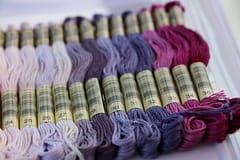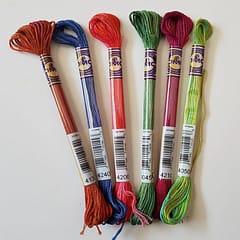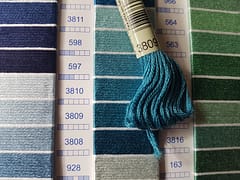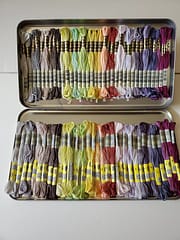You Just Can't Believe Your Own Eyes
Why Matching Color Is So Difficult
Contents
Introduction
This is a follow-up to our previous post about claims there are problems with DMC thread colors.
One thing that keeps coming up is the issue of color. Time and again people repeat the misinformation put out on social media about threads being different colors due to “dye-lots” and they are often accompanied by photos showing that yes, two skeins of the same color do indeed appear very, very different.
So let’s talk about why that is and whether it’s valid. But spoiler - they are always two separate photos, never two skeins together in the same image frame, and there’s a good reason for that …
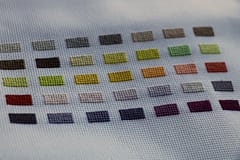
To be clear, we are not claiming that there are no such things as dye-lots which can create slight differences when solid blocks of color from different lots are stitched next to each other. This is specifically about the claim that dye-lots can produce colors so very different that they are effectively completely different thread colors.
As I’m sure most people are aware, the color of things often changes based on the lighting. Early in the morning or late in the evening may have a warm color (more orange / red) than the bright light of mid-day. Indoor lighting with old-style tungsten filament bulbs also has a warmer tone than the cold blue of a winter day. In fact, when we describe lighting we often talk about the “temperature” of it. Many devices allow the temperature of the display to be changed which alters how images will appear, and some will adjust the colors toward night as it’s meant to be kinder to your eyes.
Color temperature is why we can often get a feel for the environmental conditions just from the color of a photo. But how? How do we know things aren’t just that color vs the light changing the appearance of them?
Well, our eyes and our brains are fantastic devices that don’t just pass on the image, they do some processing on it. Because we “know” the color of many objects and things in photos our brain can correct for it even though the color may be different - this is known as “color constancy”. What we think we see isn’t always what we actually see and many optical illusions rely on this.
Don’t believe me? What color are these strawberries? The photo looks a bit greenish but they are definitely red … right?
Wrong! They are grey - your brain is adding the color.
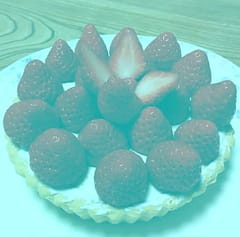
Checkout the full explanation for grey-strawberries as it’s fascinating. It can even make your brain think that a solid block of grey is really red. Tip: scroll the page so only the grey box is visible at the top and you see it as grey, then as you scroll the strawberries back into view it magically turns to red.
But it’s not just color. Our brain also fools is into believing things are darker or lighter than they really are based on the surrounding tones. Checkout this other famous illusion where the two squares marked A and B are actually the exact same shade of grey.
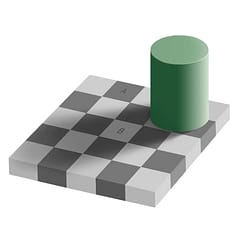
Again, checkout the full Adelson’s Checkershadow Illusion to read more about it.
So it turns out our eyes are easily fooled (or is it our brain?). But what about cameras? Surely we can rely on them as they are electronic and predictable.
Unfortunately, we can’t anymore (sad face). Unlike old cameras, that relied on allowing light to hit a photosensitive film to capture the image, new cameras do everything digitally - they have an electronic sensor to measure light but then they process the image and do their best to make it look good based on what they think they are looking at, in a similar way to how our brain did. This includes adjusting for bad lighting, to make sure that faces are correctly exposed and so on. Normally, for everyday snapshots, they do a great job because they are tuned to handle normal images.
A photo of a skein of thread is not a normal image.
Even a high-end digital camera with a quality lens and good lighting will often get it wrong. Take this photo for instance of the new thread colors. This is how it looks directly off the camera:
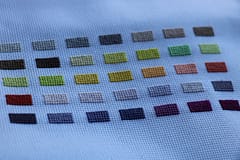
Wow, those colors are way off (screams of “see, Dye Lots!!!”) and where do you get that funky blue fabric? Except the colors are fine and the fabric is regular white Aida. Because there is so much white of the fabric in the image, the camera thinks the lighting must be wrong and so adjusts for it, thus making the image wrong. The only way to make the photo look right is to manually adjust it, in this case picking the grey-point to tell the computer how to adjust things back closer to how they appear in reality.
Here’s the adjusted version, much better and closer to what we mentally know it should look like:

That’s the exact same photo and things looked very different. Now imagine different cameras at different times and in different lighting conditions. There is little chance that things would look right even if you mailed the exact same skein of thread to be photographed it could look completely different.
Two separate photos taken independently used as evidence to show differences in skein colors only prover a complete lack of understanding about color and photography by the person posting them.
You can’t even take two photos of the exact same skein taken with the same camera immediately after each other if the framing is changed or the light fluctuates slightly and expect them to look identical.
If you ever want to paint your walls to match your sofa and take a photo of it to a paint shop, you should be told that it can’t be done (if they start mixing paint, run!). Instead you’d be asked to bring in a sample of the fabric to match against, because they know that a photo isn’t accurate enough.
Does that mean we can never trust or compare photos? Not exactly. When the exact color of the subject matters it’s possible to use a special “color card” to enable the photo to be corrected. This card contains accurately printed known reference colors that software can then use to apply corrections to the rest of the image. Unless these are being used, the skeins need to be taken in the same shot to be valid - however the photo is adjusted, the same adjustments are applied to both so even if the absolute skein color isn’t accurate, it would be valid to show if they were different from each other.

Incidentally, we use single colors to represent skeins but look at any thread and it isn’t one single color - there are lighter highlights and darker parts in shadow, the color we assign is more an “average” that we see from a distance in normal good neutral lighting.
Hopefully it’s clear by now that DMC’s thread colors are completely safe and the continued claims that this is some dye-lot issue is pure nonsense. Until and unless you see a single photo of two skeins together, consider any photos put out trying to back up this claim as mis-information, either deliberate to confuse things or due to being uninformed.
When it comes to converting images into charts, the only time a photo matters is if you’re trying to convert your own photo into a pattern to stitch. We provide some controls to enable you to correct an image to make it look better but once past that, it’s just like processing any digital image, such as scanned in artwork - the software matches threads based on the actual color of the pixels, without being thrown off or fooled by the peculiarities of how human vision works, so that the final piece will look great when stitched.
But the palette has to have been created using the correct methods. It can’t be done by holding a thread up to a screen (one is light emitting, the other is reflective color) and it can’t be done by taking a photo of it unless you have a high-end camera and careful color calibration process.
There are ways to compare color accurately but taking separate random photos posted on social media and claiming they are some “evidence” of a dye-lot issue is simply not valid and it needs to be quashed.
Please consider posting a link to this article in replies to such claims so we can spread the word and educate more people about it.
